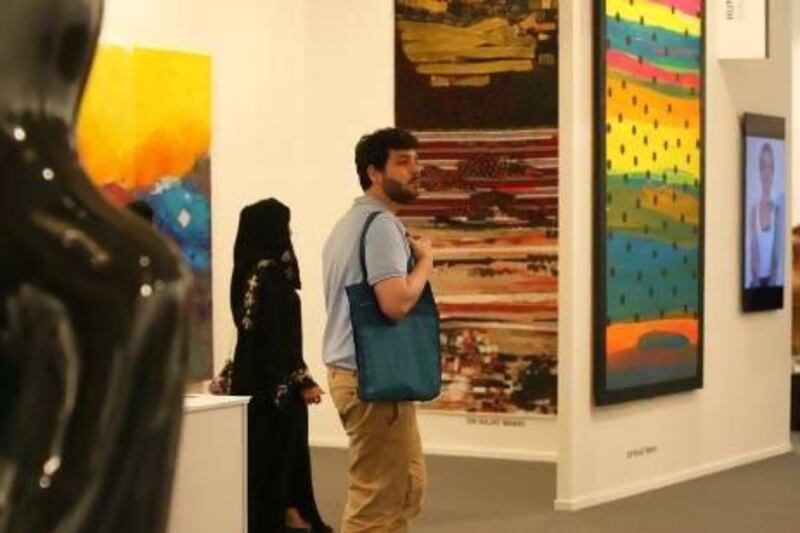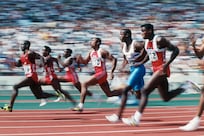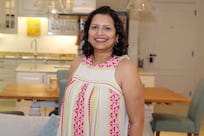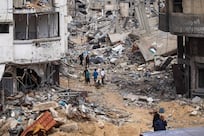In a 77th floor penthouse apartment, the former REM singer Michael Stipe is holding court on a balcony overlooking the sweeping panorama of Dubai at night.
Across the room, Generation X author Douglas Coupland is locked in a debate about the merits of fiction versus art and an impressive 3-feet-high Nadim Karam elephant sculpture is in danger of being used as a drinks stand as 350 partygoers fill the three floors of Hisham Samawi's private residence, a stone's throw from his Ayyam gallery.
Down below, hundreds of art enthusiasts are spilling out of galleries opening late for Dubai International Financial Centre's monthly art night onto a central courtyard, where Soheila Sokhanvari's stuffed horse astride a fibreglass airbag stares back mournfully at them.
Across the city, among the throngs filling Alserkal Avenue in Al Quoz, Edge of Arabia founder Stephen Stapleton is deep in discussion with a writer from The Guardian about whether the eastern provinces are rivalling Jeddah's artistic output while Oxford-educated Louisa Macmillan, a former Middle Eastern art curator for the British Museum, launches into a full-scale discourse in Arabic with Syrian artist Tammam Azzam about a recent exhibition in London.
Art Dubai has not even begun and already the mayhem of the fair has kicked off, as a phalanx of artists, curators, critics, collectors and Arabists descend on the city.
If anyone doubted Dubai's position as a thumping heartbeat at the epicentre of the Middle East's vibrant contemporary art scene, they had only to set foot in the city during last week's fair.
For some, it is a chance to network, discover new artists or buyers and form profitable and productive alliances with galleries or institutions from around the world.
For all, it is a chance to see some of the best of the region's offerings. Seventy-five galleries, 30 countries and 500 artists - and just five days to take it all in.
Tonight, the revelry will continue until dawn. Tomorrow, the real business begins.
*****
It is two days before the fair opens, but Huma Mulji's elaborate cabinet of curiosities is lying in pieces around her.
The scene resembles a children's craft project, with tools, glue sticks and marker pens scattered amid large ostrich eggs protected in bubble wrap, an array of stuffed birds in cardboard boxes and more than 100 maniacal-looking dolls cast in porcelain.
It takes two days for a team to assemble the antique wooden cabinets, bought from a market in Mulji's native Karachi, torn apart and rebuilt in the shape she wanted.
Mulji suddenly disappears, crawling into an opening in her modern take on a 16th century wunderkammer, or room of wonder. Only her feet are left dangling outside as she wrangles with her cabinet's internal wiring. All at once, the display lights up and The Miraculous Lives of This and That is brought to life.
It has been a labour of love and involved more than a year of meticulous planning for the Pakistani artist to get her artwork erected here at Art Dubai, where she is one of five winners of the Abraaj Group prize.
She travelled across Europe to research original curiosity cabinets dating back to the Renaissance while the dolls had to be ordered from Limoges in France at a cost of Dh47,260, a hefty chunk of her Dh367,300 Abraaj grant.
Too big when assembled, it took a 150ft high crane to hoist the cabinet off the roof of the home she shares in Lahore with her husband, British sculptor and landscape gardener David Alesworth, 55, and their two-year-old daughter Natasha.
Even then, the whole project nearly unravelled when Pakistani customs officers threatened to drill into the centrepiece of her display, a taxidermied cow, fearing it could be a hideaway for drugs.
"I was at customs for two hours and they were quite brutal," says Mulji, 42. "They opened up everything. Obviously it is their job to make sure nothing like that leaves the country but when you have been working on something for months and someone just pulls it apart it is devastating. Everything had to be reassembled."
Despite all the setbacks, the sculpture is up and intact by the start of the fair. The four-sided cabinet offers a bombardment of images: there is the cow's head, squeezed onto a shelf barely big enough to contain it, its unnerving glassy eyes staring out blankly and its tail and hide crammed into separate compartments; stuffed birds, some dismembered, encased behind glass windows; clusters of flies and dust epitomising the pervasive sense of death and decay running through the piece and drawers filled with an assortment of medical kits, displays of rotting teeth and casts of body parts, sourced from medical college suppliers in Pakistan.
"These are contemporary curiosities," says Mulji. "In the 16th century, it was about scientific discoveries and while collectors would own specimens of scientific things, no one knew what they were so they had a magical quality.
"They would buy objects from doctors or someone would bring back an artefact from an expedition and they would imagine what it should look like.
"There was an ignorance despite the knowledge. It was the first attempt to make sense of the world.
"That not knowing and wonder at the world is what I am interested in."
Those curiosity cabinets were owned by the wealthy and were often filled with mislabelled and frequently misunderstood objects.
Mulji saw parallels with contemporary goods spotted on Pakistani street stalls in the form of plastic dolls, imitations of western toys which became something else.
She took that idea of parody to the extreme by sending cheap Pakistani dolls to porcelain manufacturers in France and turning poor, disposable copies into valuable objects.
"I am interested in popular visual culture, and in Pakistan, where there is so much that is parodied, it completely transforms the object and becomes localised," she says.
Mulji wants to evoke the same sense of wonder of original 16th century audiences in those who view her cabinet and to leave with a notion of not really understanding what they have seen.
"There is so much happening that in one walk round, you will not get the whole story," she says. "The cabinet looks authoritative, but there is that sense of curiosity, of wanting to know more but it does not give you enough information."
Miraculous Lives is a magnet for visitors to the fair, drawing gawps, stares and murmurs of amazement. Graphic designer Diana Chamma, 25, finds it "disturbing". Artist Hamdan al Shamsi, 32, says it reminds him of his childhood nightmares and urban myths of monsters.
The fair casts Mulji as something of a curiosity herself, a role she is somewhat uncomfortable with.
Five years ago, her sculpture, Arabian Delight, a stuffed camel crammed into a suitcase, was deemed too sensitive to display at Art Dubai. It was pulled from the fair and later bought by Charles Saatchi, who included it in his show The Empire Strikes Back in London in 2010.
The controversy thrust Mulji, who often works in solitude for months at a time, into the spotlight she shies away from. Even here as a prize-winning exhibitor, she is out of her comfort zone.
"Art fairs," she says, "are not for artists. They are for gallerists and collectors. There is an economic side to the art world which artists like to pretend does not exist and something they are not part of, but obviously they are.
"I find it excruciating and painful. Sitting in a studio, the artist can believe he or she is not implicated, but we let this happen. You are faced with the realisation that you are implicated."
Being confronted by a questioning public means she comes up with a handful of sometimes meaningless sound bites: "That is what I dread.
"I am very envious of artists who seem to get through this process with much more elegance. If I could articulate it, perhaps I would be working with words."
But the Abraaj prize, she says, gives her a platform to work in a region where the audience "understands the nuances of the work more easily than an audience which is culturally different".
*****
William Lawrie and Asmaa Al-Shabibi are squabbling over the hanging of a painting.
The fair has opened to the public and panic sets in as visitors start to filter into their booth.
"It's not straight," tuts Al-Shabibi as Lawrie adjusts Nadia Kaabi-Linke's Ministry of Tourism.
"You do it then," he replies petulantly. Within minutes, though, the friends are cackling like teenagers over a shared joke.
"We get over it very quickly," Al-Shabibi says cheerfully.
The pair have good reason to be optimistic.
Their star is rising both on the Dubai art scene and internationally too.
Competition is tough at Art Dubai. The 75 galleries present, including established ones such as Pace and Victoria Miro from London and Sfeir-Semler from Beirut, are stalwarts of the global art scene and collectively, the galleries have brought works worth US$45 million (Dh156m).
While collectors have flocked from across the world, last year's sales were an estimated $40m - meaning some selections made by gallerists will not always be profitable.
This is Lawrie Shabibi's first large-scale art fair after their gallery passed its two-year anniversary a fortnight ago (most art fairs have a ban on galleries under two years old.)
Today they are basking in the afterglow of a flattering write-up in The New York Times and a string of art aficionados come to congratulate them, with one eye on the artwork they have carefully curated for their booth.
They include Glenn Lowry, the director of the Museum of Modern Art in New York, who lingers over Kaabi-Linke's Butcher Bliss installation, in which cows' stomachs are delicately cast in porcelain, Yousef Ahmed, the artist and ex-curator of Qatar's modern art museum Mathaf and Zaki Nusseibeh, the former adviser to Sheikh Zayed and a respected art collector.
The latter congratulates them and casts a lingering glance at Yasam Sasmazer's Black Sly Fox, a sculpture featuring a child staring ominously down at her shadow cast as a creature.
None of the artwork in the booth has been on display in the gallery in Al Quoz, which currently has a solo exhibition by Adel Abidin.
Instead, it features five artists who all work with three-dimensional images in different ways, whether it is Wafaa Bilal's photos of rooms reconstructed from news footage of the destruction of Iraq and filled with human ashes or Hamra Abbas' playful portraits of ordinary citizens cast in miniature in Play-Doh and blown up to outsized proportions.
"We are not here just to sell what is here, we are here to be a window onto what our gallery does," says Lawrie, 34.
"We want to show the development of an artist's ideas and the body of work they have done in different medium. It is a taster of what we have."
"The fair is a one-stop shop for the art community," adds Baghdad-born Al-Shabibi, 41. "It gives people an excuse to come to Dubai and to the fair."
The connections made at fairs are crucial; every one they have attended to date has produced a useful collector or curator who has taken a shine to their gallery's work.
Their enthusiasm is clearly infectious. Kaabi-Linke's works are snapped up, with one edition of Butcher Bliss selling for Dh71,000 to a private collector and another two placed on reserve, one by a major Turkish institution.
They also sell her Il Ponte del Rialto wax painting for Dh66,000, two Abbas photos for Dh34,000 to a local collector and two works in storage in the gallery for a collective Dh107,000.
"Our gallery is young, but we have been talking to a lot of these gallerists for years so it is great to put faces to names," says Al-Shabibi.
She was working as the managing director of Art Dubai for three years but quit in 2010 while mulling over opening her own gallery. A chance conversation with her friend Lawrie, who was then the director of contemporary Middle Eastern art for Christie's auction house, led to them setting up shop together.
Lawrie says the priority of any gallerist is to preserve the integrity of an artist: "You need to believe in your artists and their direction and the relevance of their ideas."
Fairs go hand in hand with staging shows at the gallery to show off an artist's development, says Al-Shabibi. She has already spotted an artist at the fair she would like to represent; others are usually cultivated at biennales, via other galleries or online.
"I think Art Dubai shows the eclecticism of the region," she adds. "It is about good marketing and getting to know collectors from abroad, making new relationships and meeting new clients, plus our artists get exposure to all these visitors."
*****
"I don't look for anything," declares Mona Khashoggi, "it looks for me."
Mona is a tour de force at Art Dubai, bombarding artists and gallerists with questions: Who is the artist? And what is the message?
Her infectious enthusiasm charms them all and they sit up and take note. Whether it is the Rolex, the flashing sapphire ring or the instantly recognisable family name, she gets attention wherever she goes.
Mona is the half-sister of the Saudi Arabian arms dealer Adnan Khashoggi, one of the richest men in the world. Their late father Mohammed was King Abdul Aziz Al Saud's personal doctor.
Mona's collection of about 100 works divided among her homes in Dubai, London and Saudi Arabia grew considerably after Art Dubai.
She bought several works from Jeddah's Athr gallery, including a video installation by Nasser al Salem based on a Quranic text called Guide Us Upon the Straight Path, with a heartbeat monitor forming Arabic outlines, while a Dh103,000 piece called Resting Flag by the Palestinian artist Jumana Manna, featuring a flagpole bent over a giant piece of rock, will take pride of place on her penthouse apartment balcony on the Palm Jumeirah.
"I do not like the word collector," she says. "I connect rather than collect. I always want to know the story and the meaning. I love talking to artists and go to their studios. I have to feel what they are feeling."
She comes from a creative background - one sister Soheir is a novelist, another, Samiya is an artist - while Mona is a founder of the Mansoojat Foundation, a vast archive of traditional regional Saudi attire which tours around the world.
When she was growing up, the art filling the family home was European because "that was what the interior designers chose. I never connected with them".
It was only when she began buying art for herself about 15 years ago that she developed an appetite for Middle Eastern art.
Mona admits she made mistakes at the start by paying too much or buying an entire catalogue of an artist's work.
And she has curbed her extravagance of two years ago, when she spent Dh3.7m at the fair.
Now she attends with a maximum budget of Dh50,000 per artwork - although that gets forgotten when she sees a piece she likes. She also breaks her vow to limit herself to three artworks this year.
While she still buys primarily because she is passionate about a piece, she also weighs the investment value of artwork and as a legacy for her three children. "Of course, even if I make a mistake, it is not a huge one. These are not Picassos."
Over the years, her collection has developed a strong theme, focusing on womanhood, faith and ethnicity, such as the Kezban Batibeki paintings in her lobby of two culturally-opposed women in a shoot-out, something Mona relates to as someone who straddles East and West.
"I buy emotionally and culturally," she says. "Art is a statement of emotions, whether political or cultural. It has to speak to me and to my personality. Sometimes there is no explanation for why I like it."
*****
Walking around the fair with Jérôme Sans is impossible. Every few yards, the energetic, charismatic Frenchman is stopped by artists and gallerists congratulating him on his career accolades and wanting an audience with a veteran of the industry.
Sans was the co-founder of the Palais de Tokyo in Paris and worked on the cultural programme at the Baltic Centre in London, but unexpectedly upped sticks to move to Beijing six years ago to curate at the Ullens Centre of Contemporary Art.
"Dubai is a fantastic hub where people like us get to be together," he declares. "Some of my contacts are in Beijing, but I have to come here to meet them. We never get to sit down and speak when we are there."
A fair, he adds, is never just about being a marketplace. "It has as much importance for me as a biennale in terms of learning new information and meeting people. It might be artists, curators, partners or financial sponsors."
While fairs only proffer a small percentage of the artwork he might curate for a show, the connections he makes are crucial.
"Here you can travel all over the world and see artwork from different countries under one roof," he says.
He lingers over Dubai's Isabelle van den Eynde's curation of work by the Haerizadeh brothers ("Their work is really wonderful"), praises the theatrical drama of Berlin-based Arndt's deep red booth with a solo exhibition of Wim Deloye's intricate, Gothic stainless steel sculptures and admires Galeria Continua's themed stand: "This could be one of my projects. I feel at home here."
Sans has been watching the development of the museums on Saadiyat island with a keen interest. From a curatorial point of view, the prospect of a blank canvas and of being able to design a museum and its contents from scratch is hugely exciting.
Like the gallerist and the collector, he thrives on stories: "Sometimes if I know there is something behind the work, it makes me more excited and I want to know more. Sometimes you can end up disappointed."
Biennales and exhibitions are most productive for his curatorial work and he says fairs are not enough on their own without seeing the artist working in his or her studio.
"How can you enter the full world of the artist? You leave the fair wondering what you have seen. The fair is a starting point to many things."
If it is the job of the curator to make connections, the onus on the critic is even stronger.
Omar Kholeif, an Egyptian-born editor at Ibraaz online arts magazine, wears many hats. The founder of the UK's Arab Film Festival is also a former curator at the Foundation for Art and Creative Techonology in the UK and curator at the Arab British Centre in London.
"I believe curating and critiquing are the same practice," he says. "It is about reflecting on art and thinking about it in a historical canon. My writing is about finding the frames of reference and tying together moments in history."
Grouping artists according to geography is "problematic", he says, because "you create a ghetto whereby artists are only referenced to other artists by their ethnicity and region."
He believes the role of the critic is to cross-reference artists outside those boundaries and talk about the likes of Hrair Sarkissian and Mona Hatoum in the same breath as Ryan Gander.
"The onus lies on the critic to be engaged with the overall frame of reference," he adds.
Ultimately, the roles of artist, gallerist, collector, critic and curator do not form a hierarchy but a delicate spider's web of relationships, negotiations and dealings.
"We all play a role," says Sans. "Every time we show an artist or write about him or her, we distinguish them.
"Everything has an effect on the market. We legitimise work outside the commercial aspect. We are all connected with each other.
"We need the galleries to produce and make sure artists continue to work and we all need each other otherwise the whole system fails."
Tahira Yaqoob is a regular contributor to The Review.





